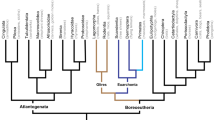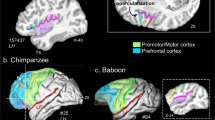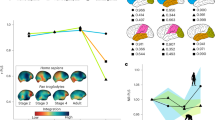Abstract
Determining how the human brain differs from nonhuman primate brains is central to understanding human behavioral evolution. There is currently dispute over whether the prefrontal cortex, which mediates evolutionarily interesting behaviors, has increased disproportionately. Using magnetic resonance imaging brain scans from 11 primate species, we measured gray, white and total volumes for both prefrontal and the entire cerebrum on each specimen (n = 46). In relative terms, prefrontal white matter shows the largest difference between human and nonhuman, whereas gray matter shows no significant difference. This suggests that connectional elaboration (as gauged by white matter volume) played a key role in human brain evolution.
This is a preview of subscription content, access via your institution
Access options
Subscribe to this journal
Receive 12 print issues and online access
$209.00 per year
only $17.42 per issue
Buy this article
- Purchase on Springer Link
- Instant access to full article PDF
Prices may be subject to local taxes which are calculated during checkout






Similar content being viewed by others
References
Deacon, T.W. The Symbolic Species: the Co-evolution of Language and the Brain (Norton, New York, 1997).
Hofman, M.A. Energy metabolism, brain size, and longevity in mammals. Q. Rev. Biol. 58, 495–512 (1983).
Harvey, P.H. & Clutton-Brock, T.H. Life history variation in primates. Evolution Int. J. Org. Evolution 39, 559–581 (1985).
Stephan, H., Frahm, H. & Baron, G. New and revised data on volumes of brain structures in insectivores and primates. Folia Primatol. (Basel) 35, 1–29 (1981).
Holloway, R.L. The failure of the gyrification index (GI) to account for volumetric reorganization in the evolution of the human brain. J. Hum. Evol. 22, 163–170 (1992).
Damasio, A.R. The frontal lobes. in Clinical Neuropsychology (eds. Heilman, K. & Valenstein, E.) 339–375 (Oxford University Press, Oxford, 1985).
Goldman-Rakic, P.S. The prefrontal landscape: implications of functional architecture for understanding human mentation and the central executive. Phil. Trans. R. Soc. Lond. B Biol. Sci. 351, 1445–1453 (1996).
Fuster, J.M. The prefrontal cortex, mediator of cross-temporal contingencies. Hum. Neurobiol. 4, 169–179 (1985).
Gabrieli, J.D., Poldrack, R.A. & Desmond, J.E. The role of left prefrontal cortex in language and memory. Proc. Natl. Acad. Sci. USA 95, 906–913 (1998).
Thompson-Schill, S.L. et al. Verb generation in patients with focal frontal lesions: a neuropsychological test of neuroimaging findings. Proc. Natl. Acad. Sci. USA 95, 15855–15860 (1998).
Vendrell, P. et al. The role of prefrontal regions in the Stroop task. Neuropsychologia 33, 341–352 (1995).
de Bruin, J.P.C. Social behavior and the prefrontal cortex. in Progress in Brain Research (eds. Uylings, H.B.M. et al.) 485–497 (Elsevier, New York, 1990).
Von Bonin, G. The frontal lobe of primates: cytoarchitectural studies. in The Frontal Lobes: Proceedings of the Association for Research in Nervous and Mental Disease, December 12 and 13, 1947 67–83 (Williams & Wilkins, Baltimore, 1948).
Holloway, R.L. The evolution of the primate brain: some aspects of quantitative relations. Brain Res. 7, 121–172 (1968).
Semendeferi, K., Lu, A., Schenker, N. & Damasio, H. Humans and great apes share a large frontal cortex. Nat. Neurosci. 5, 272–276 (2002).
Bush, E.C. & Allman, J.M. The scaling of frontal cortex in primates and carnivores. Proc. Natl. Acad. Sci. USA 101, 3962–3966 (2004).
Blinkov, S.M. & Glezer, I.I. The Human Brain in Figures and Tables (Plenum, New York, 1968).
Brodmann, K. Vergleichende Lokalisationsiehre der Grosshirnrinde in ihren Prinzipien Dargestellt auf Grund des Zellenbaues (Verlag, Leipzig, 1909).
Brodmann, K. Neue Ergebnisse über die vergleichende histologische localisation der grosshirnrinde mit besonderer berücksichtigung des stirnhirns. Anat. Anz. 41 (suppl.), 157–216 (1912).
Armstrong, E., Zilles, K., Curtis, M. & Schleicher, A. Cortical folding, the lunate sulcus and the evolution of the human brain. J. Hum. Evol. 20, 341–348 (1991).
Semendeferi, K., Armstrong, E., Schleicher, A., Zilles, K. & Van Hoesen, G.W. Prefrontal cortex in humans and apes: a comparative study of area 10. Am. J. Phys. Anthropol. 114, 224–241 (2001).
Rilling, J.K. & Insel, T.R. The primate neocortex in comparative perspective using magnetic resonance imaging. J. Hum. Evol. 37, 191–223 (1999).
McBride, T., Arnold, S.E. & Gur, R.C. A comparative volumetric analysis of the prefrontal cortex in human and baboon MRI. Brain Behav. Evol. 54, 159–166 (1999).
Uylings, H.B.M. & Van Eden, C.G. Qualitative and quantitative comparison of the prefrontal cortex in rat and in primates, including humans. in Progress in Brain Research, Vol. 85 (eds. Uylings, H.B M., Van Eden, C.G., De Bruin, J.P.C., Corner, M.A. & Feenstra, M.G.P.) 31–62 (Elsevier, New York 1990).
Semendeferi, K., Armstrong, E., Schleicher, A., Zilles, K. & Van Hoesen, G.W. Limbic frontal cortex in hominoids: a comparative study of area 13. Am. J. Phys. Anthropol. 106, 129–155 (1998).
Fuster, J.M. The Prefrontal Cortex: Anatomy, Physiology, and Neuropsychology of the Frontal Lobe edn. 2 (Raven, New York, 1989).
Ringo, J.L. Neuronal interconnection as a function of brain size. Brain Behav. Evol. 38, 1–6 (1991).
Roberts, N., Puddephat, M.J. & McNulty, V. The benefit of stereology for quantitative radiology. Br. J. Radiol. 73, 679–697 (2000).
Holloway, R.L. Brief communication: how much larger is the relative volume of area 10 of the prefrontal cortex in humans? Am. J. Phys. Anthropol. 118, 399–401 (2002).
Melhem, E.R. et al. Diffusion tensor MR imaging of the brain and white matter tractography. AJR Am. J. Roentgenol. 178, 3–16 (2002).
Rumbaugh, D.M., Savage-Rumbaugh, E.S. & Wasburn, D.A. Toward a new outlook on primate learning and behavior: complex learning and emergent processes in comparative perspective. Jpn. Psychol. Res. 38, 113–125 (1996).
Krubitzer, L. The organization of neocortex in mammals: are species differences really so different? Trends Neurosci. 18, 408–417 (1995).
Schoenemann, P.T., Budinger, T.F., Sarich, V.M. & Wang, W.S.-Y. Brain size does not predict general cognitive ability within families. Proc. Natl. Acad. Sci. USA 97, 4932–4937 (2000).
Thompson, P.M. et al. Genetic influences on brain structure. Nat. Neurosci. 4, 1253–1258 (2001).
Changizi, M.A. Principles underlying mammalian neocortical scaling. Biol. Cybern. 84, 207–215 (2001).
Schoenemann, P.T. Syntax as an emergent characteristic of the evolution of semantic complexity. Minds Machines 9, 309–346 (1999).
Savage-Rumbaugh, E.S. & Rumbaugh, D.M. The emergence of language. in Tools, Language and Cognition in Human Evolution (eds. Gibson, K.R. & Ingold, T.) 86–108 (Cambridge Univ. Press, Cambridge, 1993).
Aboitiz, F. & Garcia, V.R. The evolutionary origin of the language areas in the human brain. A neuroanatomical perspective. Brain Res. Brain Res. Rev. 25, 381–396 (1997).
Lieberman, P. On the nature and evolution of the neural bases of human language. Yearb. Phys. Anthropol. 45, 36–62 (2002).
Dunbar, R. Grooming, Gossip and the Evolution of Language (Faber and Faber, London, 1996).
Humphrey, N. The social function of intellect. in Consciousness Regained 14–28 (Oxford Univ. Press, Oxford, 1984).
Gray, J.R. & Thompson, P.M. Neurobiology of intelligence: science and ethics. Nat. Rev. Neurosci. 5, 471–482 (2004).
Wynn, T. Archaeology and cognitive function. Behav. Brain Sci. 25, 389–438 (2002).
Holloway, R.L. Toward a synthetic theory of human brain evolution. in Origins of the Human Brain (eds. Changeux, J.-P. & Chavaillon, J.) 42–54 (Clarendon, Oxford, 1995).
Zhang, Y., Brady, M. & Smith, S. Segmentation of brain MR images through a hidden Markov random field model and the expectation-maximization algorithm. IEEE Trans. Med. Imaging 20, 45–57 (2001).
Guillemaud, R. & Brady, M. Estimating the bias field of MR images. IEEE Trans. Med. Imaging 16, 238–251 (1997).
Elias, H., Hennig, A. & Schwartz, D.E. Stereology: applications to biomedical research. Physiol. Rev. 51, 158–199 (1971).
Ankney, C.D. Sex differences in relative brain size: the mismeasure of woman, too? Intelligence 16, 329–336 (1992).
Falk, D., Froese, N., Sade, D.S. & Dudek, B.C. Sex differences in brain/body relationships of Rhesus monkeys and humans. J. Hum. Evol. 36, 233–238 (1999).
Jerison, H.J. Allometry, brain size, cortical surface, and convolutedness. in Primate Brain Evolution (eds. Armstrong, E. & Falk, D.) 77–84 (Plenum, New York, 1982).
Acknowledgements
We thank J. Rilling and T. Insel for allowing us to analyze their collection of primate brain scans, and M. Grossman for six human male brains. S. Langin-Hooper and P. Silverman helped with data processing. We also thank the subjects who allowed themselves to be scanned.
Author information
Authors and Affiliations
Corresponding author
Ethics declarations
Competing interests
The authors declare no competing financial interests.
Supplementary information
Supplementary Table 1
Effects of blurring on volume estimation. (PDF 40 kb)
Supplementary Table 2
Average absolute and relative voxel sizes. (PDF 48 kb)
Supplementary Table 3
Effects of increasing voxel size on volume estimation. (PDF 57 kb)
Rights and permissions
About this article
Cite this article
Schoenemann, P., Sheehan, M. & Glotzer, L. Prefrontal white matter volume is disproportionately larger in humans than in other primates. Nat Neurosci 8, 242–252 (2005). https://doi.org/10.1038/nn1394
Received:
Accepted:
Published:
Issue Date:
DOI: https://doi.org/10.1038/nn1394
This article is cited by
-
Evolving characterization of the human hyperdirect pathway
Brain Structure and Function (2023)
-
A map of white matter tracts in a lesser ape, the lar gibbon
Brain Structure and Function (2023)
-
Myelin dysfunction drives amyloid-β deposition in models of Alzheimer’s disease
Nature (2023)
-
Effective connectivity of brain networks controlling human thermoregulation
Brain Structure and Function (2022)
-
Proceedings from the Albert Charitable Trust Inaugural Workshop on white matter and cognition in aging
GeroScience (2020)



